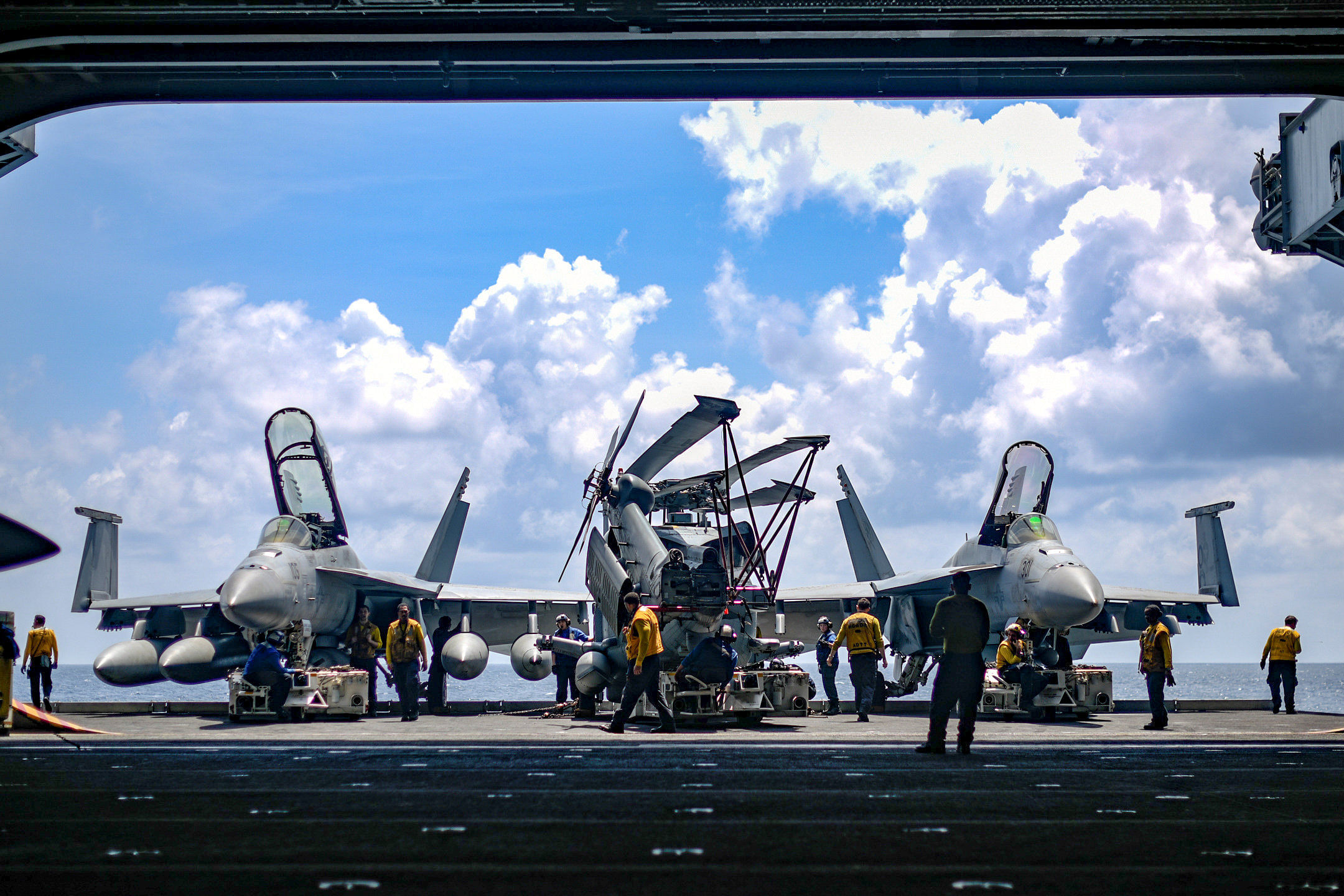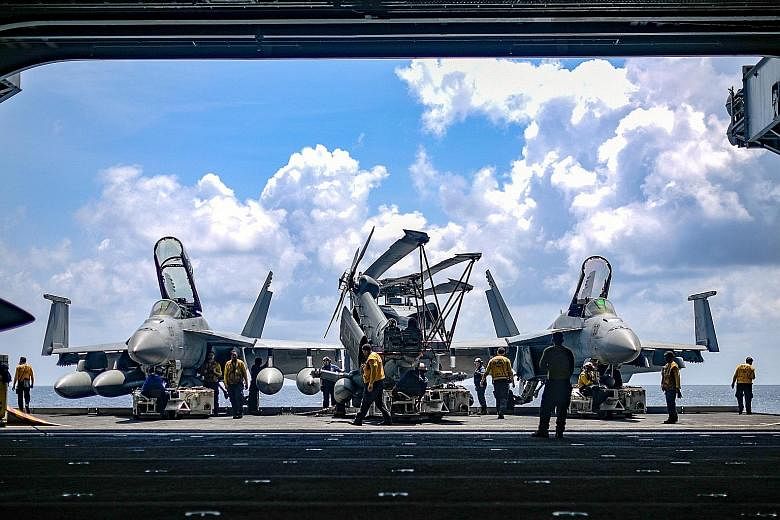It is said the one that God loves gets an invitation by the US Navy to take a rickety propeller-driven mail transport plane on a jaw-juddering ride across the South China Sea to land on a Nimitz-class aircraft carrier.
This was what I got to do last month. On the flight deck of the USS Theodore Roosevelt, our group of 20 journalists, scholars and civil servants oohed and aahed as we observed F/A-18E/F Super Hornets blasting off into the air and later making their way back safely in a series of "arrested landings", the force of their engines held back by sturdy metallic cables straddling the deck.
To witness the highly-choreographed series of take-offs and landings is to observe an aerial ballet that showcases the power of the American military in the Asia-Pacific. It's heady stuff, like the whiff of jet fuel in the air. But aerial ballets are one thing, the United States' diplomatic dance with China quite another. If strategy is the ability to connect means to ends, the Trump administration's approach to the Asia-Pacific does not seem to uphold a benign US-led regional order in the face of China's rise and assertiveness.
To his credit, President Donald Trump has been a major player in the current rapprochement on the Korean peninsula. But he will have to be mindful about Washington's responses to North Korea's overtures. Putting the presence of US troops on the negotiating table, as US Secretary of Defence James Mattis has indicated, will be of major concern to US allies.
This is particularly so following Mr Trump's refusal to return to the Trans-Pacific Partnership (TPP), a key pillar of America's Asia-Pacific strategy.
And what about US action to support its "rules-based order" rhetoric? This has been the foundational narrative for the "Quad". Comprising Australia, Japan, India and the US, the quartet seeks to uphold principles such as the rule of law, maritime security and freedom of navigation.

In March, Vietnam's state-run PetroVietnam withdrew permission for Spanish energy firm Repsol for a drilling project in Vietnam's exclusive economic zone (EEZ). Reportedly, China had threatened to start hostilities if Repsol went ahead with the project. According to Mr Ankit Panda, a senior editor at The Diplomat, Vietnam - the front-line claimant state in the South China Sea - "appears to be hung out to dry". The incident comes four years after the Haiyang Shiyou 981 incident, when China deployed a massive oil rig in Vietnam's EEZ - the most serious incident since China's occupation of Mischief Reef in 1995.
If Twitter-prone Mr Trump is thinking tactically, the Chinese are acting strategically. China aims to be a "world power" come 2049, not by upending the US-led regional order, but by coercing and inducing partners and allies of the US to bend to China's will.
What's the US strategy then in the face of Chinese muscle-flexing?
I do not agree with analysts who argue that the US should cede regional primacy to China. Rather, I tend to agree with scholars like Dr Thomas Wright, author of All Measures Short Of War, who has called for "responsible competition" with China, through elements of balancing, development of US relationships in the region and the search for cooperation with Beijing (in other words, not so different from former US president Barack Obama's "rebalance" strategy).
It will be laudable for the US and its partners to continue to push on the Quad principles of freedom of navigation and rule of law, and hopefully get like-minded countries in the region to express support for the same principles.
The Quad must be on to something because China is irritated. Chinese Foreign Minister Wang Yi has called the Quad's Indo-Pacific strategy a "headline-grabbing exercise" that is like the "foam on the sea".
China is certainly well entrenched on the features it has built in the South China Sea, with the completion of facilities such as hangers, possible missile emplacements and storage facilities.
On Wednesday, it was reported that China has installed long-range anti-ship and anti-aircraft missiles on three features there.
The US should continue with its freedom of navigation operations in the South China Sea, and work in tandem with its allies and partners to continue what I would term a "coordinated uncoordinated" plan to exercise freedom of navigation. So while the patrols are done by individual countries (and thus appear uncoordinated), the coordination is at the back-end.
Last month, three Australian naval vessels were challenged by Chinese naval ships as they transited the South China Sea towards Vietnam. China's defence ministry said the Chinese navy's operations were "lawful ... professional and safe". The Australian Broadcasting Corp cited an Australian official as saying the exchanges between the two navies were "robust". In a statement to Reuters, Canberra said the Australian military - as it has done for decades - will continue to exercise rights under international law to maintain "freedom of navigation and overflight, including in the South China Sea".
Australia has for decades conducted Operation Gateway, which provides maritime surveillance patrols in the northern Indian Ocean and the South China Sea. In May last year, Japan sent its Izumo helicopter carrier on a three-month tour through the South China Sea. And now the Europeans want in. Last month, Britain's Royal Navy said three ships will be in the region, ostensibly to monitor North Korea. Speaking in Sydney earlier this week, French President Emmanuel Macron said France wanted to work with the Quad to ensure a "balance" in the region vis-a-vis China. In 2016, French Defence Minister Jean-Yves Le Drian had called on the European Union to conduct "regular and visible" patrols in the area.
All the examples given underscore one thing - countries need to continue to exercise their freedom of navigation rights under international law, particularly in the South China Sea. Essentially, the logic is "use it or lose it".
While it will be hard for Mr Trump to rejoin the TPP, the US and its allies should also continue to work on a viable alternative to China's Belt and Road Initiative. Former secretary of state Rex Tillerson said the BRI amounted to "predatory economics" that saddles countries with debt. The US has signed a US$500 million (S$667 million) agreement with Nepal to improve the transportation and electricity network. Likewise, India and Japan are cooperating on an LNG project in Sri Lanka. In February, it was reported that Australian Prime Minister Malcolm Turnbull was working with Quad partners on an alternative to BRI. Few details, however, have emerged.
In the end, a viable Quad strategy avoids hard containment of China, but seeks to show Beijing that there is a group of countries that can bring power to bear when needed.
Boxer Mike Tyson once famously said: "Everybody has a plan until they get punched in the face." While there is merit to the argument that plans have their limits, one should not be woefully unprepared either. For many in the region, the hope is that the US does not end up like its fighter planes on "arrested landings" - in this case, a victim of arrested strategy.
- The writer is a Shangri-La Dialogue Senior Fellow for Asia-Pacific Security at the International Institute for Strategic Studies.

